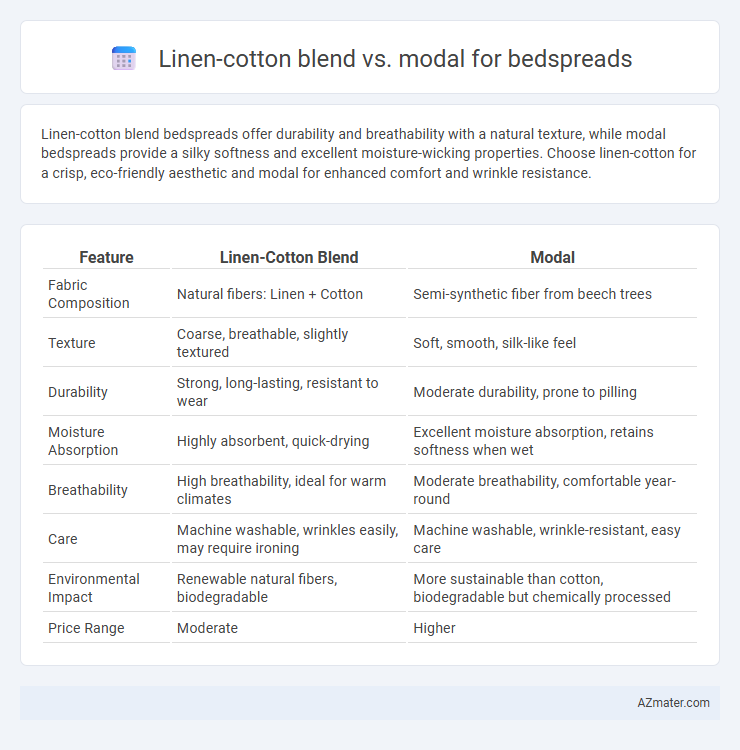Linen-cotton blend bedspreads offer durability and breathability with a natural texture, while modal bedspreads provide a silky softness and excellent moisture-wicking properties. Choose linen-cotton for a crisp, eco-friendly aesthetic and modal for enhanced comfort and wrinkle resistance.
Table of Comparison
| Feature | Linen-Cotton Blend | Modal |
|---|---|---|
| Fabric Composition | Natural fibers: Linen + Cotton | Semi-synthetic fiber from beech trees |
| Texture | Coarse, breathable, slightly textured | Soft, smooth, silk-like feel |
| Durability | Strong, long-lasting, resistant to wear | Moderate durability, prone to pilling |
| Moisture Absorption | Highly absorbent, quick-drying | Excellent moisture absorption, retains softness when wet |
| Breathability | High breathability, ideal for warm climates | Moderate breathability, comfortable year-round |
| Care | Machine washable, wrinkles easily, may require ironing | Machine washable, wrinkle-resistant, easy care |
| Environmental Impact | Renewable natural fibers, biodegradable | More sustainable than cotton, biodegradable but chemically processed |
| Price Range | Moderate | Higher |
Introduction to Linen-Cotton Blend and Modal Bedspreads
Linen-cotton blend bedspreads offer a natural, breathable fabric combining the durability and texture of linen with the softness and smoothness of cotton, making them ideal for year-round comfort and easy maintenance. Modal bedspreads, made from beech tree cellulose, provide exceptional moisture-wicking properties, a silky feel, and resistance to shrinking and pilling, enhancing longevity and comfort. Both materials cater to distinct preferences: linen-cotton blends suit those seeking natural fibers with a rustic aesthetic, while modal appeals to users prioritizing softness and moisture management.
Material Composition and Origins
Linen-cotton blends combine natural flax fibers with soft cotton, providing durability, breathability, and moisture-wicking qualities, typically sourced from Europe and India. Modal, a semi-synthetic fabric made from beech tree pulp primarily produced in Austria and South Korea, offers a silky texture, high absorbency, and resistance to shrinkage. The linen-cotton blend tends to be cozier and more textured, while modal is smoother and often chosen for its eco-friendly regenerated cellulosic fiber content.
Softness and Texture Comparison
Linen-cotton blends offer a textured, breathable fabric with a natural crispness that softens over time, providing durability and a slightly rustic feel ideal for casual or elegant bedspreads. Modal excels in softness due to its smooth, silky fibers derived from beech trees, creating a luxurious, lightweight texture that drapes beautifully without wrinkles. For a bedspread prioritizing softness and a smooth touch, modal outperforms linen-cotton blends, while the latter provides a more structured, tactile experience.
Breathability and Temperature Regulation
Linen-cotton blend bedspreads excel in breathability due to natural fibers that wick moisture and promote airflow, making them ideal for warm climates. Modal fabric offers superior softness and moisture absorption but tends to retain more heat, which may reduce comfort in hot conditions. Choosing between the two depends on prioritizing enhanced ventilation of linen-cotton blends or the silky feel of modal with moderate temperature regulation.
Durability and Longevity
Linen-cotton blends combine the natural strength of linen fibers with the softness of cotton, offering exceptional durability and resistance to wear, making them ideal for long-lasting bedspreads. Modal, a semi-synthetic fabric made from beech tree pulp, provides a silky feel but is generally less durable over time compared to linen-cotton blends, especially under frequent washing. For bedspread longevity, linen-cotton blends maintain structural integrity better, resisting pilling and fading more effectively than modal fabrics.
Moisture-Wicking Properties
Linen-cotton blend bedspreads excel in moisture-wicking due to the natural breathability and absorbency of both fibers, making them ideal for warm climates or hot sleepers. Modal fibers, derived from beech tree pulp, offer exceptional moisture-wicking properties by quickly absorbing and evaporating sweat, maintaining a dry and comfortable sleeping environment. While linen-cotton blends provide durability and a textured feel, modal bedspreads stand out for their silky softness combined with superior moisture management.
Maintenance and Care Requirements
Linen-cotton blends require gentle washing in cold water and minimal exposure to direct sunlight to prevent fabric weakening, while modal bedding is highly durable, resisting shrinking and fading even after multiple washes. Linen-cotton bedspreads benefit from air drying or low-heat tumble drying to maintain texture, whereas modal is more wrinkle-resistant and can withstand machine drying without significant damage. Both fabrics demand careful handling, but modal offers a lower-maintenance option with its enhanced durability and color retention.
Sustainability and Eco-Friendliness
Linen-cotton blends offer strong sustainability credentials with natural fibers that are biodegradable and require less water and pesticides during cultivation compared to purely cotton textiles. Modal, derived from beech tree pulp, is also eco-friendly due to its renewable raw material and energy-efficient production, with superior softness and moisture-wicking properties. Choosing between the two depends on valuing the agricultural impact of linen-cotton blends or the closed-loop production process and enhanced comfort of modal for an eco-conscious bedspread.
Price and Value for Money
Linen-cotton blend bedspreads are generally more affordable than modal, offering a balance of durability and breathability ideal for budget-conscious buyers. Modal bedspreads usually come at a higher price due to their silky texture and superior moisture-wicking properties, providing exceptional value for those prioritizing softness and luxury. Comparing price per durability and comfort, linen-cotton blends deliver long-lasting value, while modal justifies its cost with enhanced softness and ease of care.
Which Material is Best for Your Bedspread?
Linen-cotton blends offer exceptional breathability, durability, and a natural texture that softens with each wash, making them ideal for those who prioritize comfort and longevity in a bedspread. Modal, a semi-synthetic fiber derived from beech tree pulp, delivers a silky smooth feel, excellent moisture-wicking properties, and resistance to shrinkage, perfect for a sleek, hypoallergenic bedroom aesthetic. Choosing the best material depends on whether you prefer the rustic charm and durability of linen-cotton or the luxurious softness and moisture management of modal for your bedspread.

Infographic: Linen-cotton blend vs Modal for Bedspread
 azmater.com
azmater.com